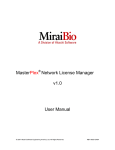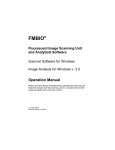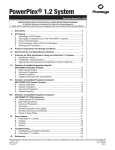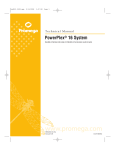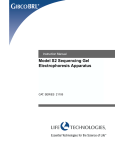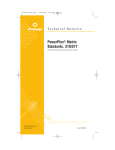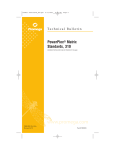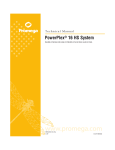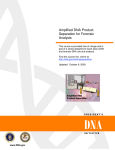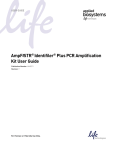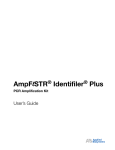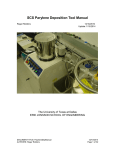Download Complete Protocol
Transcript
TECHNICAL MANUAL PowerPlex® 16 BIO System Instructions for Use of Product DC6540 Revised 7/15 TMD016 PowerPlex® 16 BIO System All technical literature is available at: www.promega.com/protocols/ Visit the web site to verify that you are using the most current version of this Technical Manual. E-mail Promega Technical Services if you have questions on use of this system: [email protected] 1. Description.......................................................................................................................................... 2 2. Product Components and Storage Conditions......................................................................................... 3 3. Before You Begin.................................................................................................................................. 4 4. Protocols for DNA Amplification Using the PowerPlex® 16 BIO System.................................................... 5 4.A. Amplification Setup..................................................................................................................... 5 4.B. Amplification Thermal Cycling...................................................................................................... 7 5. Detection of Amplified Fragments Using the Hitachi FMBIO® II Fluorescence Imaging System.................. 9 5.A. Polyacrylamide Gel Preparation.................................................................................................... 9 5.B. Gel Pre-Run.............................................................................................................................. 11 5.C. Sample Preparation and Loading................................................................................................ 12 5.D. Gel Electrophoresis................................................................................................................... 13 5.E.Detection.................................................................................................................................. 13 6. Data Analysis..................................................................................................................................... 15 6.A. Background Adjustment............................................................................................................. 15 6.B. Color Separation Using Individual Bands.................................................................................... 16 6.C. Color Separation Using Bands In a Single Lane............................................................................ 16 6.D.Autobanding............................................................................................................................. 17 6.E.Controls.................................................................................................................................... 17 6.F. Allelic Ladders.......................................................................................................................... 18 6.G.Results..................................................................................................................................... 18 7. Troubleshooting................................................................................................................................ 21 8. References......................................................................................................................................... 25 9. Appendix........................................................................................................................................... 27 9.A. Advantages of Using the Loci in the PowerPlex® 16 BIO System.................................................... 27 9.B. Power of Discrimination............................................................................................................ 31 9.C. DNA Extraction and Quantitation Methods and Automation Support............................................. 32 9.D. The Internal Lane Standard 600 BIO........................................................................................... 32 9.E. Preparing the PowerPlex® 16 BIO System PCR Amplification Mix................................................. 33 9.F. Composition of Buffers and Solutions.......................................................................................... 34 9.G. Related Products....................................................................................................................... 35 9.H. Summary of Changes................................................................................................................. 36 Promega Corporation · 2800 Woods Hollow Road · Madison, WI 53711-5399 USA · Toll Free in USA 800-356-9526 · 608-274-4330 · Fax 608-277-2516 www.promega.com TMD016 · Revised 7/15 1 1.Description STR (short tandem repeat) loci consist of short, repetitive sequence elements 3–7 base pairs in length (1–4). These repeats are well distributed throughout the human genome and are a rich source of highly polymorphic markers, which may be detected using the polymerase chain reaction (5–8). Alleles of STR loci are differentiated by the number of copies of the repeat sequence contained within the amplified region and are distinguished from one another using fluorescence detection following electrophoretic separation. The PowerPlex® 16 BIO System(a–e) is used for human identification applications including forensic analysis, relationship testing and research use. The system allows coamplification and three-color detection of sixteen loci (fifteen STR loci and Amelogenin). The PowerPlex® 16 BIO System contains the loci Penta E, D18S51, D21S11, TH01, D3S1358, FGA, TPOX, D8S1179, vWA, Amelogenin, Penta D, CSF1PO, D16S539, D7S820, D13S317 and D5S818. In the system, one primer specific for Penta E, D18S51, D21S11, TH01 and D3S1358 is labeled with fluorescein (FL); one primer specific for FGA, TPOX, D8S1179, vWA and Amelogenin is labeled with Rhodamine Red™-X; and one primer specific for Penta D, CSF1PO, D16S539, D7S820, D13S317 and D5S818 is labeled with 6-carboxy-4´,5´-dichloro2´,7´-dimethoxy-fluorescein (JOE). All sixteen loci are amplified simultaneously in a single tube and analyzed in a single gel lane. The PowerPlex® 16 Monoplex System, Penta E (Fluorescein) (Cat.# DC6591) and PowerPlex® 16 Monoplex System, Penta D (JOE) (Cat.# DC6651) are available to amplify the Penta E and Penta D loci, respectively. Each monoplex system allows amplification of a single locus to confirm results obtained with the PowerPlex® 16 System, PowerPlex® 16 BIO System or PowerPlex® 2.1 System. The monoplex systems also can be used to re-amplify DNA samples when one or more of the loci do not amplify initially due to nonoptimal amplification conditions or poor DNA quality. The PowerPlex® 16 BIO System is designed specifically for use with the Hitachi FMBIO® II Fluorescence Imaging System. It provides all of the materials necessary to amplify STR regions of purified human genomic DNA except for AmpliTaq Gold® DNA polymerase. This manual contains separate protocols for use of the PowerPlex® 16 BIO System with the Perkin-Elmer model 480 and GeneAmp® PCR system 9600, 9700 and 2400 thermal cyclers in addition to protocols for separation and detection of amplified materials. Information about other Promega fluorescent STR systems is available upon request from Promega or online at: www.promega.com/geneticidentity/ 2 Promega Corporation · 2800 Woods Hollow Road · Madison, WI 53711-5399 USA · Toll Free in USA 800-356-9526 · 608-274-4330 · Fax 608-277-2516 TMD016 · Revised 7/15 www.promega.com 2. Product Components and Storage Conditions PRODUCT PowerPlex® 16 BIO System S I Z E C A T. # 400 reactions DC6540 Not For Medical Diagnostic Use. Cat.# DC6540 contains sufficient reagents for 400 reactions of 25µl each. Includes: Pre-amplification Components Box (Blue Label) • 4 × 300µl Gold STHR 10X Buffer • 4 × 250µl PowerPlex® 16 BIO 10X Primer Pair Mix • 25µl 2800M Control DNA, 10ng/µl Post-amplification Components Box (Beige Label) • 4 × 125µl PowerPlex® 16 BIO Allelic Ladder Mix • 100µl Matrix 16 BIO • 2 × 300µl Internal Lane Standard (ILS) 600 BIO • 2 × 1ml Bromophenol Blue Loading Solution • 250µl Gel Tracking Dye The PowerPlex® 16 BIO Allelic Ladder Mix is provided in a separate, sealed bag for shipping. This component should be moved to the post-amplification box after opening. Storage Conditions: Store all components except the 2800M Control DNA at –30°C to –10°C in a nonfrost-free freezer. Store the 2800M Control DNA at 2 to 10°C. The PowerPlex® 16 BIO 10X Primer Pair Mix, PowerPlex® 16 BIO Allelic Ladder Mix, Matrix 16 BIO and Internal Lane Standard 600 BIO are light-sensitive and must be stored in the dark. We strongly recommend that pre-amplification and post-amplification reagents be stored and used separately with different pipettes, tube racks, etc. Promega Corporation · 2800 Woods Hollow Road · Madison, WI 53711-5399 USA · Toll Free in USA 800-356-9526 · 608-274-4330 · Fax 608-277-2516 www.promega.com TMD016 · Revised 7/15 3 3. Before You Begin The application of PCR-based typing for forensic or paternity casework requires validation studies and quality-control measures that are not contained in this manual (9,10). The quality of the purified DNA, as well as small changes in buffers, ionic strength, primer concentrations, choice of thermal cycler and thermal cycling conditions, can affect PCR success. We suggest strict adherence to recommended procedures for amplification, as well as for electrophoresis and fluorescence detection. Additional research and validation are required if any modifications are made to the recommended protocols. PCR-based STR analysis is subject to contamination by minute amounts of human DNA. Extreme care should be taken to avoid cross-contamination when preparing sample DNA, handling primer pairs, assembling amplification reactions and analyzing amplification products. Reagents and materials used prior to amplification (Gold STHR 10X Buffer, 2800M Control DNA and PowerPlex® 16 BIO 10X Primer Pair Mix) are provided in a separate box and should be stored separately from those used following amplification (PowerPlex® 16 BIO Allelic Ladder Mix, Internal Lane Standard 600 BIO, Matrix 16 BIO, Bromophenol Blue Loading Solution and Gel Tracking Dye). Always include a negative control reaction (i.e., no template) to detect reagent contamination. We highly recommend the use of gloves and aerosol-resistant pipette tips (e.g., ART® tips, Section 9.G). Some of the reagents used in the analysis of STR products are potentially hazardous and should be handled accordingly. Table 1 describes the potential hazards associated with such reagents. Table 1. Hazardous Reagents. Reagents Hazards acrylamide suspected carcinogen, toxic ammonium persulfate oxidizer, corrosive formamide (contained in the Bromophenol Blue Loading Solution) irritant, teratogen TEMED corrosive, flammable urea irritant 4 Promega Corporation · 2800 Woods Hollow Road · Madison, WI 53711-5399 USA · Toll Free in USA 800-356-9526 · 608-274-4330 · Fax 608-277-2516 TMD016 · Revised 7/15 www.promega.com 4. Protocols for DNA Amplification Using the PowerPlex® 16 BIO System Materials to Be Supplied by the User • model 480 or GeneAmp® system 9600, 9700 or 2400 thermal cycler (Applied Biosystems) •microcentrifuge • 0.5ml or 0.2ml (thin-walled) microcentrifuge tubes, MicroAmp® optical 96-well reaction plate or MicroAmp® 8-strip reaction tubes (Applied Biosystems) • aerosol-resistant pipette tips (see Section 9.G) • AmpliTaq Gold® DNA polymerase (Applied Biosystems) • Nuclease-Free Water (Cat.# P1193) • Mineral Oil (Cat.# DY1151, for use with the thermal cycler model 480) Note: If using the GeneAmp® PCR system 9600, 9700 or 2400 thermal cyclers, use 0.2ml MicroAmp® 8-strip reaction tubes or MicroAmp® plate. For the Perkin-Elmer model 480, we recommend 0.5ml GeneAmp® thin-walled reaction tubes. We routinely amplify 0.5–1ng of template DNA in a 25µl reaction volume using the protocols detailed below. Expect to see more intense bands for smaller loci and less intense bands for larger loci if more than the recommended amount of template is used. Reduce the amount of template DNA or the number of cycles to correct this. The PowerPlex® 16 BIO System is optimized for the GeneAmp® PCR system 9600 thermal cycler. Amplification protocols for the GeneAmp® PCR systems 9700 and 2400 thermal cyclers and Perkin-Elmer model 480 thermal cycler are provided. 4.A. Amplification Setup The use of gloves and aerosol-resistant pipette tips is highly recommended to prevent cross-contamination. Keep all pre-amplification and post-amplification reagents in separate rooms. Prepare amplification reactions in a room dedicated for reaction setup. Use equipment and supplies dedicated for amplification setup. Meticulous care must be taken to ensure successful amplification. A guide to amplification troubleshooting is provided in Section 7. ! The concentration of 2800M Control DNA was determined by measuring absorbance at 260nm. Quantification of this control DNA by other methods, such as qPCR, may result in a different value. Prepare a fresh DNA dilution for each set of amplifications. Do not store diluted DNA (e.g., 0.25ng/μl or less). 1. Thaw Gold STHR 10X Buffer and PowerPlex® 16 BIO 10X Primer Pair Mix. Notes: 1. Mix reagents by vortexing for 15 seconds before each use. Do not centrifuge the 10X Primer Pair Mix after vortexing, as this may cause the primers to be concentrated at the bottom of the tube. 2. A precipitate may form in Gold STHR 10X Buffer. If this occurs, warm the buffer briefly at 37°C, then vortex until the precipitate is in solution. Promega Corporation · 2800 Woods Hollow Road · Madison, WI 53711-5399 USA · Toll Free in USA 800-356-9526 · 608-274-4330 · Fax 608-277-2516 www.promega.com TMD016 · Revised 7/15 5 4.A. Amplification Setup (continued) 2. Determine the number of reactions to be set up. This should include positive and negative control reactions. Add 1 or 2 reactions to this number to compensate for pipetting error. While this approach does consume a small amount of each reagent, it ensures that you will have enough PCR amplification mix for all samples. It also ensures that each reaction contains the same PCR amplification mix. 3. Place one clean, 0.2ml or 0.5ml reaction tube for each reaction into a rack, and label appropriately. Alternatively, use a MicroAmp® plate, and label appropriately. 4. Add the final volume of each reagent listed in Table 2 into a sterile tube. Mix gently. Table 2 shows the component volumes per reaction. A worksheet to calculate the required amount of each PCR amplification mix component is provided in Section 9.E (Table 10). Table 2. PCR Amplification Mix for the PowerPlex® 16 BIO System. PCR Amplification Mix Component1 nuclease-free water to a final volume of 25.0µl 2.5µl Gold STHR 10X Buffer PowerPlex® 16 BIO 10X Primer Pair Mix AmpliTaq Gold DNA polymerase ® 2 template DNA (0.5–1ng) 3 total reaction volume Volume Per Sample 2.5µl 0.8µl (4u) up to 19.2µl 25µl Add nuclease-free water to the PCR amplification mix first; then add Gold STHR 10X Buffer, PowerPlex® 16 BIO 10X Primer Pair Mix and AmpliTaq Gold® DNA polymerase. The template DNA will be added at Step 6. 1 2 Assumes AmpliTaq Gold® DNA polymerase is at 5u/µl. If the concentration is different, the volume of enzyme used must be adjusted accordingly. Store DNA templates in nuclease-free water or TE–4 buffer (10mM Tris-HCl [pH 8.0], 0.1mM EDTA). If the DNA template is stored in TE buffer that is not pH 8.0 or contains a higher EDTA concentration, the volume of DNA added should not exceed 20% of the final reaction volume. Amplification efficiency and quality can be greatly altered by changes in pH (due to added Tris-HCl), available magnesium concentration (due to chelation by EDTA), or other PCR inhibitors, which may be present at low concentrations depending on the source of the template DNA and the extraction procedure used. 3 ! 6 Amplification of >2ng of DNA template results in an imbalance in band intensities from locus to locus. The smaller loci show greater amplification yield than larger loci. Reducing the number of cycles in the amplification program by 2 to 4 cycles (i.e., 10/20 or 10/18 cycling) can improve locus-to-locus balance. Promega Corporation · 2800 Woods Hollow Road · Madison, WI 53711-5399 USA · Toll Free in USA 800-356-9526 · 608-274-4330 · Fax 608-277-2516 TMD016 · Revised 7/15 www.promega.com 5. Pipet PCR amplification mix into each reaction tube. 6. Pipet each template DNA (0.5–1ng) into the respective tube containing PCR amplification mix. 7. For the positive amplification control, vortex the tube of 2800M Control DNA; then dilute an aliquot to 0.5ng or 1ng in the desired template DNA volume. Pipet 0.5–1ng of the diluted DNA into a microcentrifuge tube containing PCR amplification mix. Note: To store diluted 2800M Control DNA, dilute the DNA to 0.5ng/μl in TE–4 buffer with 20μg/ml glycogen and store at 4°C. Do not store dilutions performed in water. 8. For the negative amplification control, pipet nuclease-free water or TE–4 buffer instead of template DNA into a reaction tube containing PCR amplification mix. 9. If using the GeneAmp® PCR System 9600, 9700 or 2400 thermal cycler and MicroAmp® reaction tubes or plates, no addition of mineral oil to the reaction tubes is required. However, if using the model 480 thermal cycler and GeneAmp® reaction tubes, add one drop of mineral oil to each tube before closing. Note: Allow the mineral oil to flow down the side of the tube and form an overlay to limit sample loss or crosscontamination due to splattering. 10. Optional: Briefly centrifuge the tubes to bring contents to the bottom and remove any air bubbles. 4.B. Amplification Thermal Cycling This manual contains protocols for use of the PowerPlex® 16 BIO System with the Perkin-Elmer model 480 and GeneAmp® PCR system 9600, 9700 and 2400 thermal cyclers. For information about other thermal cyclers, please contact Promega Technical Services by e-mail: [email protected] Amplification and detection instrumentation may vary. Testing at Promega shows that 10/22 cycles work well for 0.5–1ng of purified DNA templates. For higher amounts of input DNA or to decrease sensitivity, fewer cycles, such as 10/16, 10/18 or 10/20, should be evaluated. In-house validation should be performed. 1. Place the tubes or MicroAmp® plate in the thermal cycler. 2. Select and run a recommended protocol. The preferred protocols for use with the GeneAmp® PCR system 9600, 9700 and 2400 and Perkin-Elmer model 480 thermal cyclers are provided below. 3. After completion of the thermal cycling protocol, store amplified samples at –20°C in a light-protected box. Note: Long-term storage of amplified samples at 4°C or higher may produce degradation products. Promega Corporation · 2800 Woods Hollow Road · Madison, WI 53711-5399 USA · Toll Free in USA 800-356-9526 · 608-274-4330 · Fax 608-277-2516 www.promega.com TMD016 · Revised 7/15 7 Protocol for the GeneAmp® PCR System 9700 Thermal Cycler1 Protocol for the GeneAmp® PCR System 2400 Thermal Cycler 95°C for 11 minutes, then: 95°C for 11 minutes, then: 96°C for 1 minute, then: 96°C for 1 minute, then: ramp 100% to 94°C for 30 seconds ramp 29% to 60°C for 30 seconds ramp 23% to 70°C for 45 seconds for 10 cycles, then: ramp 100% to 94°C for 30 seconds ramp 100% to 60°C for 30 seconds ramp 23% to 70°C for 45 seconds for 10 cycles, then: ramp 100% to 90°C for 30 seconds ramp 29% to 60°C for 30 seconds ramp 23% to 70°C for 45 seconds for 22 cycles, then: ramp 100% to 90°C for 30 seconds ramp 100% to 60°C for 30 seconds ramp 23% to 70°C for 45 seconds for 22 cycles, then: 60°C for 30 minutes 60°C for 30 minutes 4°C soak 4°C soak Protocol for the GeneAmp® PCR System 9600 Thermal Cycler Protocol for the Perkin-Elmer Model 480 Thermal Cycler 95°C for 11 minutes, then: 95°C for 11 minutes, then: 96°C for 1 minute, then: 96°C for 2 minutes, then: 94°C for 30 seconds ramp 68 seconds to 60°C (hold for 30 seconds) ramp 50 seconds to 70°C (hold for 45 seconds) for 10 cycles, then: 94°C for 1 minute 60°C for 1 minute 70°C for 1.5 minutes for 10 cycles, then: 90°C for 30 seconds ramp 60 seconds to 60°C (hold for 30 seconds) ramp 50 seconds to 70°C (hold for 45 seconds) for 22 cycles, then: 90°C for 1 minute 60°C for 1 minute 70°C for 1.5 minutes for 22 cycles, then: 60°C for 30 minutes 60°C for 30 minutes 4°C soak 4°C soak When using the GeneAmp® PCR System 9700 thermal cycler, the ramp rates indicated in the cycling program must be set, and the program must be run in 9600 ramp mode. 1 The ramp rates are set in the ramp rate modification screen. While viewing the cycling program, navigate to the ramp rate modification screen by selecting “More”, then “Modify”. On the ramp rate modification screen the default rates for each step are 100%. The rate under each hold step is the rate at which the temperature will change to that hold temperature. Figure 1 shows the ramp rates for the GeneAmp® PCR System 9700 thermal cycler. The ramp mode is set after “start” has been selected for the thermal cycling run. A Select Method Options screen appears. Select 9600 ramp mode, and enter the reaction volume. 8 Promega Corporation · 2800 Woods Hollow Road · Madison, WI 53711-5399 USA · Toll Free in USA 800-356-9526 · 608-274-4330 · Fax 608-277-2516 TMD016 · Revised 7/15 www.promega.com 94.0°C 100% 60.0°C 29% 70.0°C 23% 3 tmp 22 cycles 90.0°C 100% 60.0°C 29% 70.0°C 23% 7486MA 3 tmp 10 cycles Figure 1. The ramp rates for the GeneAmp® PCR System 9700 thermal cycler. 5. Detection of Amplified Fragments Using the Hitachi FMBIO® II Fluorescence Imaging System Materials to Be Supplied by the User (Solution compositions are provided in Section 9.F.) • polyacrylamide gel electrophoresis apparatus • dry heating block, water bath or thermal cycler • power supply (4,000 volt) • squaretooth comb, 35cm, 60 wells (cut in half for 30 wells/gel), 0.4mm thick (Owl Scientific Cat.# S2S-60A) •Nalgene® tissue culture filter (0.2 micron) • • • • • • aerosol-resistant pipette tips (Section 9.G) low-fluorescence glass plates: 43cm x 19cm x 0.4mm (The Gel Company, Cat.# GG047-B0505S) spacers, 0.4mm clear spacers (The Gel Company, Cat.# SGR47-036) SA-43 Extension (Lab Repco, Cat.# 31096423) for use with 43cm glass plates clamps (e.g., large office binder clamps) 50% Long Ranger® gel solution (Cambrex Cat.# 50611), Long Ranger Singel® pack for ABI sequencers 377–36cm (Cambrex Cat.# 50691) or PAGE-PLUS™ concentrate, 40% solution (Amresco, Inc., Cat.# E562) • TBE 10X buffer • 10% Ammonium Persulfate (Cat.# V3131) • Urea (Cat.# V3171) •TEMED • bind silane (methacryloxypropyltrimethoxysilane), for use with squaretooth combs •Liqui-Nox® detergent • filter set for the PowerPlex® 16 BIO System (MiraiBio Cat.# 11999-246-00) 5.A. Polyacrylamide Gel Preparation Acrylamide (Long Ranger® gel solution) is a neurotoxin and suspected carcinogen; avoid inhalation and contact with skin. Read the warning label, and take the necessary precautions when handling this substance. Always wear gloves and safety glasses when working with acrylamide solutions. ! Promega Corporation · 2800 Woods Hollow Road · Madison, WI 53711-5399 USA · Toll Free in USA 800-356-9526 · 608-274-4330 · Fax 608-277-2516 www.promega.com TMD016 · Revised 7/15 9 5.A. Polyacrylamide Gel Preparation (continued) 1. Thoroughly clean glass plates twice with hot water and a 1% Liqui-Nox® solution. Rinse extremely well with deionized water. Allow the glass plates to air-dry in a dust-free environment. Dust particles will be detected in the scan using the 577 filter. Use lint-free paper (e.g., Kimwipes® tissues) to clean the glass plates both before pouring the gel and prior to scanning. Air from a bulb may also be used to remove dust. ! If using a squaretooth comb, one of the glass plates requires bind silane treatment. The plates do not require special silane treatment when using a sharkstooth comb. Bind Silane Treatment of Glass Plate Prepare fresh binding solution in a chemical fume hood by adding 3µl of bind silane to a 1.5ml microcentrifuge tube containing 1.0ml of 0.5% acetic acid in 95% ethanol. Wipe the short plate with a Kimwipes® tissue saturated with freshly prepared binding solution. Wait 5 minutes for the binding solution to dry. Wipe the comb area of the glass plate 5–6 times with 95% ethanol and Kimwipes® tissues to remove excess binding solution. 2. Assemble the glass plates by placing 0.4mm side spacers between the front and rear glass plates, using binder clamps to hold them in place (3–4 clamps on each side). A bottom spacer is neither required nor recommended. Place the assembly horizontally on a test tube rack or similar support. Note: We recommend clear spacers. If white or opaque spacers are used, place black electrical tape on the longer plate over the spacer area to prevent the spacers from being included in the scan, which can affect the signal and background. 3. Prepare a 5% Long Ranger® or 6% PAGE-PLUS™ acrylamide solution by combining the ingredients listed in Table 3. Table 3. Preparation of 5% Long Ranger® Polyacrylamide Gels. Component 5% Gel Final Concentration urea 18.0g 6M deionized water 26.0ml — 5.0ml 1X 5% 10X TBE Buffer 50% Long Ranger gel solution 5.0ml total volume 50ml Component ® 1 6% PAGE-PLUS™ Gel Final Concentration urea 18g 6M deionized water 24ml — 10X TBE buffer 5ml 1X 40% PAGE-PLUS™ gel solution 7.5ml 6% total volume 50ml Long Ranger Singel Packs may also be used. 1 10 ® Promega Corporation · 2800 Woods Hollow Road · Madison, WI 53711-5399 USA · Toll Free in USA 800-356-9526 · 608-274-4330 · Fax 608-277-2516 TMD016 · Revised 7/15 www.promega.com 4. Filter the acrylamide solution through a 0.2 micron filter, and pour into a squeeze bottle. 5. Add the appropriate amounts of TEMED and 10% ammonium persulfate to the acrylamide solution, and mix gently. Component 5% Long Ranger® Gel (50ml) TEMED 18.0g 10% ammonium persulfate 26.0ml 6. Pour the gel by starting at the well end of the plates and carefully pouring the acrylamide between the horizontal glass plates. Allow the solution to fill the top width of the plates. Slightly tilt the plates to assist movement of the solution to the bottom of the plates while maintaining a constant flow of solution. When the solution begins to flow out from the bottom, position the plates horizontally. 7. Insert the squaretooth comb between the glass plates until the teeth are almost completely inserted into the gel, or insert one 14cm doublefine (49 point) sharkstooth comb, straight side into the gel, between the glass plates (6mm of the comb should be between the two glass plates). 8. Secure the comb with three evenly spaced clamps. 9. Pour the remaining acrylamide solution into a disposable conical tube as a polymerization control. Rinse the squeeze bottle, including the spout, with water. 10. Allow polymerization to proceed for at least 1 hour. Check the polymerization control to be sure that polymerization has occurred. Note: The gel may be stored overnight if a paper towel saturated with deionized water and plastic wrap are placed around the top and bottom to prevent the gel from drying out (crystallization of the urea will destroy the gel). 5.B. Gel Pre-Run 1. Remove the clamps from the polymerized acrylamide gel. If necessary, clean any excess acrylamide from the glass plates with Kimwipes® tissues saturated with deionized water. 2. Shave any excess polyacrylamide away from the comb; remove the comb. 3. Add 1X TBE buffer to the bottom chamber of the electrophoresis apparatus. 4. Gently lower the gel/glass plates unit into the buffer with the longer plate facing out and the well side on top. 5. Secure the glass plates to the gel electrophoresis apparatus. 6. Add 1X TBE buffer to the top chamber of the electrophoresis apparatus. 7. Using a 50–100cc syringe filled with buffer, remove any air bubbles on the top of the gel. Be certain the well area is devoid of air bubbles and small pieces of polyacrylamide. Using a syringe with a bent 18-gauge needle, remove any air bubbles from the bottom of the gel. 8. Pre-run the gel to achieve a gel surface temperature of approximately 50°C. Consult the manufacturer’s instruction manual for the recommended electrophoresis conditions. Note: As a reference, we generally use 60 watts for 45–60 minutes for a 43cm gel. The gel running conditions may need to be adjusted to reach a temperature of 50°C. 9. Prepare samples and allelic ladder samples during the gel pre-run. Promega Corporation · 2800 Woods Hollow Road · Madison, WI 53711-5399 USA · Toll Free in USA 800-356-9526 · 608-274-4330 · Fax 608-277-2516 www.promega.com TMD016 · Revised 7/15 11 5.C. Sample Preparation and Loading The Internal Lane Standard 600 (ILS) BIO is included in the PowerPlex® 16 BIO System for use as an internal size marker. With this approach, only 2–3 lanes of the PowerPlex® 16 BIO Allelic Ladder Mix are required per gel. The Matrix 16 BIO is included with the system to aid in color separation. The Matrix 16 BIO should be run in one or two lanes per gel. 1. Prepare a loading cocktail by combining and mixing the ILS 600 BIO and Bromophenol Blue Loading Solution as follows: Volume Per Sample × Internal Lane Standard BIO 1µl × Bromophenol Blue Loading Solution 3µl × Number of Lanes = Total Volume 2. Vortex for 10–15 seconds. 3. Combine 4µl of prepared loading cocktail and 2µl of amplified sample or PowerPlex® 16 BIO Allelic Ladder Mix. Vortex the allelic ladder prior to pipetting. 4. For matrix lanes, combine 2.5µl of Matrix 16 BIO and 2.5µl of Bromophenol Blue Loading Solution. Note: If the fluorescent signal is too intense, dilute samples in Gold STHR 1X Buffer before mixing with loading cocktail or use less DNA template in the amplification reactions. 5. Optional: Place 2µl of Gel Tracking Dye and 3µl of Gold STHR 1X Buffer in one tube. The Gel Tracking Dye contains both bromophenol blue and xylene cyanol. This dye is loaded in the outermost lane of the gel at least 2 lanes from the nearest sample and is used as a visual indicator of migration. Note: The xylene cyanol dye in the Gel Tracking Dye will fluoresce when scanned with the Hitachi FMBIO® II Fluorescence Imaging System. Leave at least two empty lanes between the Gel Tracking Dye and sample lanes. 6. Briefly centrifuge samples to bring contents to the bottom of the tubes. 7. Just prior to loading the gel, denature samples by heating at 95°C for 2 minutes, and immediately chill on crushed ice or in an ice water bath. 8. After the pre-run, use a 50–100cc syringe filled with buffer and fitted with a bent 18-gauge needle to flush urea from the well area. If using a squaretooth comb, do not reinsert the comb, as the samples will be loaded directly into the wells. If using a sharkstooth comb, insert the teeth into the gel approximately 1–2mm, and leave the comb inserted in the gel during both gel loading and electrophoresis. 9. Load 3µl of each denatured sample into the respective wells. The loading process should take no longer than 20 minutes to prevent the gel from cooling. 12 Promega Corporation · 2800 Woods Hollow Road · Madison, WI 53711-5399 USA · Toll Free in USA 800-356-9526 · 608-274-4330 · Fax 608-277-2516 TMD016 · Revised 7/15 www.promega.com 5.D. Gel Electrophoresis 1. After loading, run the gel using the same conditions as in Section 5.B. Observe the lane containing Gel Tracking Dye to monitor sample migration. In a 5% Long Ranger® acrylamide gel, xylene cyanol dye migrates at approximately 190 bases, and in a 6% PAGE-PLUS™ acrylamide gel, xylene cyanol migrates at approximately 130 bases. In both gels, bromophenol blue migrates at less than 80 bases. 2. Based on size ranges for each locus (Table 7) and migration characteristics of the dyes contained in the Gel Tracking Dye, stop electrophoresis before the smallest locus (i.e., Amelogenin) has reached the bottom of the gel. Note: Some rare alleles (i.e., 9 repeats) for the D3S1358 locus are close to 100 bases in size. The gel should be stopped before the 100-base fragment of the ILS 600 BIO has reached the bottom. Table 4. Recommended Run Times for SA-43 Gels. Leading Edge of Xylene Cyanol (distance from bottom of gel) Approximate Run Time (60 Watts) 5% Long Ranger® 17.5cm 1 hour, 30 minutes 6% PAGE-PLUS™ 9.5cm 2 hours Gel Type These recommendations are based on a one-hour pre-run. Run time and xylene cyanol migration will vary with length of pre-run. 5.E.Detection 1. After electrophoresis, remove the gel/glass plate unit from the apparatus. Do not separate the glass plates. 2. The plates must be thoroughly cleaned before scanning. Thoroughly clean both sides of the gel/glass plate unit with deionized water and lint-free paper before scanning. Ethanol should not be used to clean the plate unit; ethanol fluoresces and may be detected as background by the FMBIO® instrument. 3. The protocols in the data analysis section use the following filter setup: Filter Holder 1 (Upper Filter) 1CH 598nm 3CH 505nm Filter Holder 2 (Lower Filter) 4CH 577nm 13137MA 2CH 665nm Promega Corporation · 2800 Woods Hollow Road · Madison, WI 53711-5399 USA · Toll Free in USA 800-356-9526 · 608-274-4330 · Fax 608-277-2516 www.promega.com TMD016 · Revised 7/15 13 5.E. Detection (continued) 4. Scan the gel using the parameters listed in Table 5. Use the 598nm filter (Channel 1) to detect Rhodamine Red™-Xlabeled loci, the 665nm filter (Channel 2) to detect the Texas Red®-X-labeled ILS 600 BIO, the 505nm filter (Channel 3) to detect the fluorescein-labeled fragments and the 577nm filter (Channel 4) to detect JOE-labeled fragments. Notes: 1. Dust particles will be detected in the scan using the 577nm filter. 2. The 598nm filter in Channel 1 is acceptable for autofocusing. Table 5. Instrument Parameters for the Hitachi FMBIO® II Fluorescence Imaging System and PowerPlex® 16 BIO System. Parameter Specification Material Type acrylamide gel Resolution:Horizontal Vertical Rate Repeat 150dpi 150dpi NA 256 times Gray Level Correction Type range Cutoff Threshold: Low (background) High (signal) 50% 1% Reading Sensitivity Focusing Point1 100% (598nm channel) 100% (665nm channel) 100% (505nm channel) 100% (577nm channel) 0.0mm NA = not applicable. Focusing point of 0.0mm is based on use of 5mm glass plates. If using precast gels or thinner glass plates, the focusing point may need to be adjusted. Optimal focusing point may vary from instrument to instrument. 1 14 Promega Corporation · 2800 Woods Hollow Road · Madison, WI 53711-5399 USA · Toll Free in USA 800-356-9526 · 608-274-4330 · Fax 608-277-2516 TMD016 · Revised 7/15 www.promega.com 6. Data Analysis Four-color separation requires FMBIO® Analysis Software Macintosh® Version 8.0 or higher. The procedures included in this manual are suggestions for color separation. Further optimization may be needed for individual laboratories. 6.A. Background Adjustment 1. Create a new project using the raw data files. 2. Go to “Multi”, and switch the display mode to “over”. 3. Enlarge the project window to display four channels. Note: The initial multicolor image may not be displayed as four colors. 4. Highlight and change the colors in the boxes so that Channel 1 is red, Channel 2 is blue, Channel 3 is green and Channel 4 is yellow. 5. Perform background adjustment prior to multicolor separation. Adjust the background for each channel (Figure 2). a. From the multicolor image, zoom in on an area of medium-intensity band to 200X or 300X. b. From the multicolor image, find a medium-intensity band in the channel (color) of interest. c. Switch to the black and white image for that channel. d. From the Gray Level Adjustment window, highlight the Low (Background) percent box. e. Draw a box in the area directly above and almost on top of the medium-intensity band (Figure 2). Select “Set”. This often results in a background above 90%. Note: Choose background while at 200–300X for each color. f. Do not adjust the signal. Signal adjustment should be performed only if the signal is unusually high. If signal needs adjustment, highlight the High (Signal) percent box, then select a band of medium intensity for signal adjustment. Select “Set”. 6. Repeat Step 5 for each of the other three colors by starting at the colored image and choosing the appropriate color band. 7. Review the gel image in the Over Display Mode under “Multi”. Lanes containing the Matrix 16 BIO sample should have this pattern repeated three times from the largest to smallest band: red, green, blue and yellow. Note: Make sure that the channels are set as shown in Step 4. 8. Perform color separation using the method described in Section 6.B or 6.C. 3484TA07_1A Enlarged view Figure 2. Area of scan to choose for background adjustment. Promega Corporation · 2800 Woods Hollow Road · Madison, WI 53711-5399 USA · Toll Free in USA 800-356-9526 · 608-274-4330 · Fax 608-277-2516 www.promega.com TMD016 · Revised 7/15 15 6.B. Color Separation Using Individual Bands Perform the multicolor separation using individual bands from the Matrix 16 BIO lane(s). The Matrix 16 BIO sample should have this pattern repeated three times from the largest to smallest band: red, green, blue and yellow. 1. From the multicolor image, zoom in on matrix lane to 200X or 300X. 2. Highlight “Color Separation” under “Multi”. A color separation window will be displayed, and the “Basis Image” shown will be red. 3. Draw a box around a red band (top band of the matrix), avoiding as much background as possible, and select “Set”. 4. Repeat Steps 2 and 3 for each of the other colors by changing the “Basis Image” to the color of the band that is highlighted. 5. Select “OK” to generate the separated images. 6. Select “OK” when asked if you want to execute color separation. 6.C. Color Separation Using Bands In a Single Lane The multicolor separation can be done using a single lane. Use the Matrix 16 BIO lane. Read the section on image analysis tools in the FMBIO® user’s manual before creating a color separation matrix with the Multi-Band Color Separator. 1. Select “1 D-Gel” under Tools. 2. Select “Layer”, and highlight “filename.2CH”. Select “OK”. 3. Move the range to just above the top and just below the bottom of the matrix bands. 4. Select the single lane tool 5. Select “Autoband” on the side menu. Make sure that 12 bands are autobanded. 6. Select “Color Separation” from the Multi menu, then select “Multi”. A Multi-Band Color Separator window will be displayed. 7. Select “Copy”, or highlight a stored pattern. The pattern should have three sets of four colors with the pattern: red, green, blue and yellow. 8. If the pattern is not displayed correctly, highlight the colored box under “Use”, and select the correct color. Note: The Matrix 16 BIO pattern can be stored by highlighting “Save as” and typing in “Matrix 16 BIO”. 9. Select “OK”. from the side menu, and drag it down the matrix sample lane. 10. Select “OK” from the Multi-Band Color Separator window. 16 Promega Corporation · 2800 Woods Hollow Road · Madison, WI 53711-5399 USA · Toll Free in USA 800-356-9526 · 608-274-4330 · Fax 608-277-2516 TMD016 · Revised 7/15 www.promega.com 6.D.Autobanding 1. View and analyze the gel image to determine allele designations as recommended in the FMBIO® user’s manual. For information regarding the use of FMBIO® Analysis Software, contact the Hitachi Technical Support Group (510-337-2000 or [email protected]). 2. We recommend the following autobanding parameters: Parameter 3. Default Setting Recommended Settings Starting Slope 2.5 1.5–2.0 Ending Slope 2.5 1.5–2.0 Duration 0.2 0.1 Noise Level 20 15–30 The data from the four-color analysis should contain the following: Channel/Filter Display as (Color) Dye Label Loci 1/598nm Red Rhodamine Red™-X FGA, TPOX, D8S1179, vWA, Amelogenin 2/665nm Blue Texas Red -X Internal Lane Standard 600 BIO 3/505nm Green Fluorescein Penta E, D18S51, D21S11, TH01, D3S1358 4/577nm Yellow JOE Penta D, CSF1PO, D16S539, D7S820, D13S317, D5S818 ® 6.E.Controls Observe the lanes containing the negative controls. Using the protocols defined in this manual, the negative controls should be devoid of amplification products. Observe the lanes containing the 2800M Control DNA. Compare the 2800M Control DNA allelic repeat sizes with the locus-specific allelic ladder. The expected 2800M Control DNA allele designations for each locus are listed in Table 8 (Section 9.A). Promega Corporation · 2800 Woods Hollow Road · Madison, WI 53711-5399 USA · Toll Free in USA 800-356-9526 · 608-274-4330 · Fax 608-277-2516 www.promega.com TMD016 · Revised 7/15 17 6.F. Allelic Ladders In general, allelic ladders contain fragments of the same lengths as either most or all known alleles for the locus. Allelic ladder sizes and repeat units are listed in Table 7 (Section 9.A). Visual comparison between allelic ladder and amplified samples of the same locus allows precise assignment of alleles. Analysis using specific instrumentation also allows allele determination by comparing amplified sample fragments with either allelic ladders, internal size standards or both (see software documentation from instrument manufacturer). When using an internal lane standard, the calculated lengths of allelic ladder components will differ from those listed in Table 7. This is due to differences in migration resulting from sequence differences between allelic ladder fragments and internal lane standard fragments. Dye labels also affect fragment migration. Note: It may prove helpful to confirm that your gel analysis software identifies the correct number of alleles present in the allelic ladder lanes prior to analysis of sample lanes. The PowerPlex® 16 BIO Allelic Ladder has 86 alleles in the fluorescein channel (20 Penta E alleles, 22 D18S51 alleles, 25 D21S11 alleles, 10 TH01 alleles and 9 D3S1358 alleles), 61 alleles in the JOE channel (14 Penta D alleles, 10 CSF1PO alleles, 9 D16S539 alleles, 9 D7S820 alleles, 9 D13S317 alleles and 10 D5S818 alleles), and 55 alleles in the Rhodamine Red™-X channel (20 FGA alleles, 8 TPOX alleles, 12 D8S1179 alleles, 13 vWA alleles and 2 Amelogenin alleles). 6.G.Results Representative results using the PowerPlex® 16 BIO System are shown in Figures 3 and 4. 18 Promega Corporation · 2800 Woods Hollow Road · Madison, WI 53711-5399 USA · Toll Free in USA 800-356-9526 · 608-274-4330 · Fax 608-277-2516 TMD016 · Revised 7/15 www.promega.com A. 505nm Scan: Fluorescein B. 577nm Scan: JOE L 1 2 3 4 5 L Penta E C. 598nm Scan: Rhodamine Red™-X L 1 2 3 4 5 L L 1 2 3 4 5 L Penta D CSF1PO FGA D18S51 D16S539 TPOX D7S820 D8S1179 D21S11 D13S317 TH01 vWA D5S818 Amel. 6330TA D3S1358 Figure 3. The PowerPlex® 16 BIO System. Five single-source DNA samples (lanes 1–5) were amplified with the PowerPlex® 16 BIO Primer Pair Mix using 1ng of DNA template. Lane 1 shows the results using 1ng of 9947A DNA. Lanes labeled L contain allelic ladders for each of the sixteen loci contained in the system. All materials were separated using a 6% PAGE-PLUS™ acrylamide gel and detected using the Hitachi FMBIO® II Fluorescence Imaging System. Panel A. A scan using a 505nm filter showing the fluorescein-labeled loci Penta E, D18S51, D21S11, TH01 and D3S1358. Panel B. A scan using a 577nm filter showing the JOE-labeled loci Penta D, CSF1PO, D16S539, D7S820, D13S317 and D5S818. Panel C. A scan using a 598nm filter showing the Rhodamine Red™-X-labeled loci FGA, TPOX, D8S1179, vWA and Amelogenin. Promega Corporation · 2800 Woods Hollow Road · Madison, WI 53711-5399 USA · Toll Free in USA 800-356-9526 · 608-274-4330 · Fax 608-277-2516 www.promega.com TMD016 · Revised 7/15 19 A. 505nm Scan: Fluorescein B. 577nm Scan: JOE L 1 2 3 4 5 C. 598nm Scan: Rhodamine Red™-X L12345 D. 665nm Scan: Texas Red®-X L12345 600 550 Penta E Penta D FGA CSF1PO D18S51 D16S539 500 475 450 425 400 375 350 TPOX 325 300 D7S820 D8S1179 275 250 D21S11 D13S317 225 200 TH01 180 vWA 160 D5S818 D3S1358 140 Amel. 100 6331TA 120 Figure 4. Amplification of various template amounts with the PowerPlex® 16 BIO System. A single-source DNA template (2, 1, 0.5 or 0.2ng) was amplified. The results are shown in lanes 1–4, respectively. Lane 5 shows the amplification results with no DNA template. Lanes labeled L contain the PowerPlex® 16 BIO Allelic Ladder. All materials were separated using a 6% PAGE-PLUS™ acrylamide gel and detected using the Hitachi FMBIO® II Fluorescence Imaging System. Panel A. A scan using a 505nm filter showing the fluorescein-labeled loci Penta E, D18S51, D21S11, TH01 and D3S1358. Panel B. A scan using a 577nm filter showing the JOE-labeled loci Penta D, CSF1PO, D16S539, D7S820, D13S317 and D5S818. Panel C. A scan using a 598nm filter,showing the Rhodamine Red™-X-labeled loci FGA, TPOX, D8S1179, vWA and Amelogenin. Panel D. A scan using a 665nm filter, which results in an image of the Texas Red®-X-labeled Internal Lane Standard 600 BIO. 20 Promega Corporation · 2800 Woods Hollow Road · Madison, WI 53711-5399 USA · Toll Free in USA 800-356-9526 · 608-274-4330 · Fax 608-277-2516 TMD016 · Revised 7/15 www.promega.com 7.Troubleshooting For questions not addressed here, please contact your local Promega Branch Office or Distributor. Contact information available at: www.promega.com. E-mail: [email protected] Symptoms Causes and Comments Faint or absent allele bandsImpure template DNA. Because of the small amount of template used, this is rarely a problem. Depending on the DNA extraction procedure used and sample source, inhibitors may be present in the DNA sample. Diluting the template in TE–4 buffer or water prior to amplification may improve results. Insufficient template DNA. Use the recommended amount of template DNA. Insufficient enzyme activity. Use the recommended amount of AmpliTaq Gold® DNA polymerase. Check the expiration date on the tube label. Incorrect amplification program. Confirm the amplification program. High salt concentration or altered pH. If the DNA template is stored in TE buffer that is not pH 8.0 or contains a higher EDTA concentration, the DNA volume should not exceed 20% of the total reaction volume. Carryover of K+, Na+, Mg2+ or EDTA from the DNA sample can negatively affect PCR. A change in pH also may affect PCR. Store DNA in TE–4 buffer (10mM Tris-HCl [pH 8.0], 0.1mM EDTA) or nuclease-free water. Primer concentration was too low. Use the recommended primer concentration. Vortex the PowerPlex® 16 BIO 10X Primer Pair Mix for 15 seconds before use. Thermal cycler, plate or tube problems. Review the thermal cycling protocols in Section 4.B. We have not tested other reaction tubes, plates or thermal cyclers. Calibrate the thermal cycler heating block if necessary. Samples were not denatured completely. Heat-denature samples at 95°C for 2 minutes, and immediately chill on crushed ice or in an ice water bath prior to loading the gel. Do not cool the samples in a thermal cycler set at 4°C, as this may lead to artifacts due to DNA re-annealing. Background level was too high (≥99%) in the black and white image in question. Repeat the color separation process starting with the gray level adjustment and using raw data, OR lower the background to a percentage equivalent to the percentage that was set in the other three images. Promega Corporation · 2800 Woods Hollow Road · Madison, WI 53711-5399 USA · Toll Free in USA 800-356-9526 · 608-274-4330 · Fax 608-277-2516 www.promega.com TMD016 · Revised 7/15 21 7. Troubleshooting (continued) Symptoms Causes and Comments Bands are fuzzy throughout the lanesPoor-quality polyacrylamide gel. Prepare acrylamide and buffer solutions using high-quality reagents. We recommend 5% Long Ranger® or 6% PAGE-PLUS™ gels. Gel pre-run was not long enough. Pre-run the gel until the gel temperature is 50°C. Electrophoresis temperature was too high. Run gel at lower temperature (40–50°C). (n–1) bands presentFollowing amplification, lengthen the final extension step from 30 minutes at 60°C to 45 minutes. n–1 bands may be generated when more than 1ng of template DNA is used. This is most commonly observed with the vWA and D3S1358 amplification products. Reduce the amount of template DNA used, or reduce the number of cycles by 2 or 4 cycles (10/20 or 10/18 cycles). Incorrect matrix patternIncorrect filter set was used or filters in the wrong position for scanning. Filters for scanning should be: Position 1: 598 Position 2: 665 Position 3: 505 Position 4: 577 Incorrect colors were assigned to the channels. Channel colors should be: Channel 1: red Channel 2: blue Channel 3: green Channel 4: yellow Extra bands visible in one or all color channelsContamination with another template DNA or previously amplified DNA. Cross-contamination can be a problem. Use aerosol-resistant pipette tips, and change gloves regularly. Artifacts of STR amplification. Amplification of STRs sometimes generates artifacts that appear as faint peaks one repeat unit smaller than the allele. Stutter band peak heights will be high if the samples are overloaded. Allelic ladder contamination. Store pre- and post-amplification components separately. Samples were not completely denatured. Heat-denature samples at 95°C for 2 minutes, and immediately chill on crushed ice or in an ice-water bath prior to loading the gel. Do not cool the samples in a thermal cycler set at 4°C, as this may lead to artifacts due to DNA re-annealing. 22 Promega Corporation · 2800 Woods Hollow Road · Madison, WI 53711-5399 USA · Toll Free in USA 800-356-9526 · 608-274-4330 · Fax 608-277-2516 TMD016 · Revised 7/15 www.promega.com Symptoms Causes and Comments BleedthroughIncorrect gray level. Use matrix lanes for color separation. Confirm that the bands selected are from the appropriate scanning channel. Incorrect colors were assigned to the channels. Repeat gray level adjustment (Figure 2). Signal was too strong. Use less template in the amplification reactions, or load less amplified sample onto the gel. Gel was not run long enough. Bands become more diffuse (less intense) during the gel run. Gels should be run until the 100-base fragment is near the bottom of the gel. Imbalance of band intensities across lociToo much template. The system is balanced using 1ng of DNA template. Using greater than 2ng will lead to overrepresented smaller alleles and underrepresented larger alleles. Use the recommended amount of template. Alternatively, reduce the number of cycles in the amplification program to improve locus-to-locus balance. Poor-quality polyacrylamide gel. Prepare acrylamide and buffer solutions using high-quality reagents. We recommend 5% Long Ranger® or 6% PAGE-PLUS™ gels. Too many cycles in the amplification protocol. Use the recommended amplification program; confirm the number of cycles. Too much enzyme present. Use the recommended amount of AmpliTaq Gold® DNA polymerase. Degraded DNA sample. Confirm the DNA integrity by running an aliquot on an agarose gel. Repurify the template DNA if necessary. Miscellaneous balance problems. Thaw the 10X Primer Pair Mix and Gold STHR 10X Buffer completely, and vortex for 15 seconds before using. Calibrate thermal cyclers and pipettes routinely. Decreasing the annealing temperatures by 1–2°C also can improve the balance. Promega Corporation · 2800 Woods Hollow Road · Madison, WI 53711-5399 USA · Toll Free in USA 800-356-9526 · 608-274-4330 · Fax 608-277-2516 www.promega.com TMD016 · Revised 7/15 23 7. Troubleshooting (continued) Symptoms Causes and Comments Imbalance of band intensities across loci Too much template from card or membrane punches of (continued)bloodstains. Cards or membranes that bind DNA tightly can contain more template DNA than recommended. This will lead to overrepresented smaller alleles and underrepresented larger alleles. Use the recommended amount of template by using a smaller punch of the membrane. Alternatively, fewer cycles of amplification can compensate for this type of unevenness of product yield (i.e., 10/20 or 10/18 cycling). Incorrect plates or tubes were used. Use only MicroAmp® tubes or plates. Due to potential differences in heat transfer capabilities, plates or tubes from other manufacturers might result in imbalance. Poor separation of alleles in ladder lanes or Gel was not run long enough. Run gel as long as possible difficulty resolving microvariant alleleswithout running the 100-base ILS fragment off the bottom of the gel. If necessary run the gel for additional time after the first scan, then scan the gel a second time to achieve greater separation of larger alleles. Scanning resolution was too low. Default scanning resolution is 150dpi. If necessary this resolution can be increased to 300dpi, which should help sharpen bands. White background with low signal intensityPart of the white spacers were scanned. Rescan the gel, being careful not to scan any portion of the spacers, remove the spacers for scanning or use black electrical tape to cover the spacers. We recommend using clear spacers. Dark, grainy background with low signal intensityFocusing point may need to be adjusted. Perform multiple scans using different focusing points. Adjust focusing point if necessary. Plates were improperly washed. Improper washing of plates can cause a soap residue to build up on the plates, which can cause background fluorescence. Plate may be soaked in 1N NaOH to remove residue. Do not use ethanol to clean plates prior to scanning. 24 Promega Corporation · 2800 Woods Hollow Road · Madison, WI 53711-5399 USA · Toll Free in USA 800-356-9526 · 608-274-4330 · Fax 608-277-2516 TMD016 · Revised 7/15 www.promega.com 8.References 1. Edwards, A. et al. (1991) DNA typing with trimeric and tetrameric tandem repeats: Polymorphic loci, detection systems, and population genetics. In: The Second International Symposium on Human Identification 1991, Promega Corporation, 31–52. 2. Edwards, A. et al. (1991) DNA typing and genetic mapping with trimeric and tetrameric tandem repeats. Am. J. Hum. Genet. 49, 746–56. 3. Edwards, A. et al. (1992) Genetic variation at five trimeric and tetrameric tandem repeat loci in four human population groups. Genomics 12, 241–53. 4. Warne, D. et al. (1991) Tetranucleotide repeat polymorphism at the human β-actin related pseudogene 2 (actbp2) detected using the polymerase chain reaction. Nucl. Acids Res. 19, 6980. 5. Ausubel, F.M. et al. (1993) Unit 15: The polymerase chain reaction. In: Current Protocols in Molecular Biology, Vol. 2, Greene Publishing Associates, Inc., and John Wiley and Sons, NY. 6. Sambrook, J., Fritsch, E.F. and Maniatis, T. (1989) Chapter 14: In vitro amplification of DNA by the polymerase chain reaction. In: Molecular Cloning: A Laboratory Manual, Second Edition, Cold Spring Harbor Laboratory Press, Cold Spring Harbor, New York. 7. PCR Technology: Principles and Applications for DNA Amplification (1989) ed., Erlich, H.A., Stockton Press, New York. 8. PCR Protocols: A Guide to Methods and Applications (1990) eds., Innis, M.A. et al. Academic Press, San Diego. 9. Presley, L.A. et al. (1992) The implementation of the polymerase chain reaction (PCR) HLA DQ alpha typing by the FBI laboratory. In: The Third International Symposium on Human Identification 1992, Promega Corporation, 245–69. 10. Hartmann, J.M. et al. (1991) Guidelines for a quality assurance program for DNA analysis. Crime Laboratory Digest 18, 44–75. 11. Levinson, G. and Gutman, G.A. (1987) Slipped-strand mispairing: A major mechanism for DNA sequence evolution. Mol. Biol. Evol. 4, 203–21. 12. Schlotterer, C. and Tautz, D. (1992) Slippage synthesis of simple sequence DNA. Nucl. Acids Res. 20, 211–5. 13. Smith, J.R. et al. (1995) Approach to genotyping errors caused by nontemplated nucleotide addition by Taq DNA polymerase. Genome Res. 5, 312–7. 14. Magnuson, V.L. et al. (1996) Substrate nucleotide-determined non-templated addition of adenine by Taq DNA polymerase: Implications for PCR-based genotyping. BioTechniques 21, 700–9. 15. Walsh, P.S., Fildes, N.J. and Reynolds, R. (1996) Sequence analysis and characterization of stutter products at the tetranucleotide repeat locus vWA. Nucl. Acids Res. 24, 2807–12. 16. Moller, A., Meyer, E. and Brinkmann, B. (1994) Different types of structural variation in STRs: HumFES/FPS, HumVWA and HumD21S11. Int. J. Leg. Med. 106, 319–23. Promega Corporation · 2800 Woods Hollow Road · Madison, WI 53711-5399 USA · Toll Free in USA 800-356-9526 · 608-274-4330 · Fax 608-277-2516 www.promega.com TMD016 · Revised 7/15 25 8. References (continued) 17. Brinkmann, B., Moller A. and Wiegand, P. (1995) Structure of new mutations in 2 STR systems. Int. J. Leg. Med. 107, 201–3. 18. Griffiths, R. et al. (1998) New reference allelic ladders to improve allelic designation in a multiplex STR system. Int. J. Legal Med. 111, 267–72. 19. Bär W. et al. (1997) DNA recommendations: Further report of the DNA Commission of the ISFH regarding the use of short tandem repeat systems. Int. J. Legal Med. 110, 175–6. 20. Gill, P. et al. (1997) Considerations from the European DNA profiling group (EDNAP) concerning STR nomenclature. Forensic Sci. Int. 87, 185–92. 21. Frégeau, C.J. et al. (1995) Characterization of human lymphoid cell lines GM9947 and GM9948 as intra- and interlaboratory reference standards for DNA typing. Genomics 28, 184–97. 22. Levadokou, E. et al. (2001) Allele frequencies for fourteen STR loci of the PowerPlex® 1.1 and 2.1 Multiplex Systems and Penta D Locus in Caucasians, African-Americans, Hispanics and other populations of the United States of America and Brazil. J. Forensic Sci. 46, 736–61. 23. Lins, A.M. et al. (1998) Development and population study of an eight-locus short tandem repeat (STR) multiplex system. J. Forensic Sci. 43, 1168–80. 24. Puers, C. et al. (1993) Identification of repeat sequence heterogeneity at the polymorphic STR locus HUMTH01[AATG]n and reassignment of alleles in population analysis using a locus-specific allelic ladder. Am. J. Human Genet. 53, 953–8. 25. Hammond, H. et al. (1994) Evaluation of 13 short tandem repeat loci for use in personal identification applications. Am. J. Hum. Genet. 55, 175–89. 26. Bever, R.A. and Creacy, S. (1995) Validation and utilization of commercially available STR multiplexes for parentage analysis. In: Proceedings from the Fifth International Symposium on Human Identification 1994, Promega Corporation, 61–8. 27. Sprecher, C.J. et al. (1996) A general approach to analysis of polymorphic short tandem repeat loci. BioTechniques 20, 266–76. 28. Lins, A.M. et al. (1996) Multiplex sets for the amplification of polymorphic short tandem repeat loci—silver stain and fluorescent detection. BioTechniques 20, 882–9. 29. Jones, D.A. (1972) Blood samples: Probability of discrimination. J. Forensic Sci. Soc. 12, 355–9. 30. Brenner, C. and Morris, J.W. (1990) In: Proceedings from the International Symposium on Human Identification 1989, Promega Corporation, 21–53. 31. Mandrekar, P.V., Krenke, B.E. and Tereba, A. (2001) DNA IQ™: The intelligent way to purify DNA. Profiles in DNA 4(3), 16. 32. Krenke, B.E. et al. (2005) Development of a novel, fluorescent, two-primer approach to quantitative PCR. Profiles in DNA 8(1), 3–5. Additional STR references can be found at: www.promega.com/geneticidentity/ 26 Promega Corporation · 2800 Woods Hollow Road · Madison, WI 53711-5399 USA · Toll Free in USA 800-356-9526 · 608-274-4330 · Fax 608-277-2516 TMD016 · Revised 7/15 www.promega.com 9.Appendix 9.A. Advantages of Using the Loci in the PowerPlex® 16 BIO System The loci included in the PowerPlex® 16 BIO System (Tables 6, 7 and 8) were selected because they satisfy the needs of several major standardization bodies throughout the world. For example, the United States Federal Bureau of Investigation (FBI) has selected 13 STR core loci for typing prior to searching or including (submitting) samples in the Combined DNA Index System (CODIS), the U.S. national database of convicted offender profiles. The PowerPlex® 16 BIO System amplifies all CODIS core loci in a single reaction. The PowerPlex® 16 BIO System also contains two low-stutter, highly polymorphic pentanucleotide repeat loci, Penta E and Penta D. These additional loci add significantly to the discrimination power of the system, making the PowerPlex® 16 BIO System a single-amplification system with a power of exclusion sufficient to resolve paternity disputes definitively. In addition, the extremely low stutter seen with Penta E and Penta D makes them ideal loci to evaluate DNA mixtures often encountered in forensic casework. Finally, the Amelogenin locus is included in the PowerPlex® 16 BIO System to allow gender identification of each sample. Table 8 lists the system alleles revealed in commonly available standard DNA templates. We have carefully selected STR loci and primers to avoid or minimize artifacts, including those associated with Taq DNA polymerase, such as repeat slippage and terminal nucleotide addition. Repeat slippage (11,12), sometimes called “n–4 bands,” “stutter” or “shadow bands,” is due to the loss of a repeat unit during DNA amplification, somatic variation within the DNA, or both. The amount of this artifact observed depends primarily on the locus and DNA sequence being amplified. Terminal nucleotide addition (13,14) occurs when Taq DNA polymerase adds a nucleotide, generally adenine, to the 3´ ends of amplified DNA fragments in a template-independent manner. The efficiency with which this occurs varies with different primer sequences. Thus, an artifact band one base shorter than expected (i.e., missing the terminal addition) is sometimes seen. We have modified primer sequences and added a final extension step of 60°C for 30 minutes (15) to the amplification protocol to provide conditions for essentially complete terminal nucleotide addition when recommended amounts of DNA template are used. The presence of microvariant alleles (alleles differing from one another by lengths other than the repeat length) complicates interpretation and assignment of alleles. There appears to be a correlation between a high degree of polymorphism, a tendency for microvariants and increased mutation rate (16,17). Thus, FGA and D21S11 display numerous, relatively common microvariants. For reasons yet unknown, the highly polymorphic Penta E locus does not display frequent microvariants (Table 7). Promega Corporation · 2800 Woods Hollow Road · Madison, WI 53711-5399 USA · Toll Free in USA 800-356-9526 · 608-274-4330 · Fax 608-277-2516 www.promega.com TMD016 · Revised 7/15 27 Table 6. The PowerPlex® 16 BIO System Locus-Specific Information. GenBank® Locus and Locus Definition Repeat Sequence1 5´→ 3´ Label Chromosomal Location Penta E FL 15q D18S51 FL 18q21.3 D21S11 FL 21q11–21q21 TH01 FL 11p15.5 D3S1358 FL 3p FGA Rhodamine Red™-X 4q28 HUMFIBRA, Human fibrinogen alpha chain gene TTTC Complex (18) TPOX Rhodamine Red™-X 2p24–2pter HUMTPOX, Human thyroid peroxidase gene AATG D8S1179 Rhodamine Red™-X 8q vWA Rhodamine Red™-X 12p12–pter Amelogenin2 Rhodamine Red™-X Xp22.1–22.3 and Y Penta D JOE 21q CSF1PO JOE 5q33.3–34 STR Locus NA AAAGA HUMUT574 HUMD21LOC AGAA (18) TCTA Complex (18) HUMTH01, Human tyrosine hydroxylase gene NA AATG (18) TCTA Complex NA TCTA Complex (18) HUMVWFA31, Human von Willebrand factor gene TCTA Complex (18) HUMAMEL, Human Y chromosomal gene for Amelogenin-like protein NA NA AAAGA HUMCSF1PO, Human c-fms proto-oncogene for CSF-1 receptor gene AGAT D16S539 JOE 16q24–qter NA GATA D7S820 JOE 7q11.21–22 NA GATA D13S317 JOE 13q22–q31 NA TATC D5S818 JOE 5q23.3–32 NA AGAT 1 The August 1997 report (19,20) of the DNA Commission of the International Society for Forensic Haemogenetics (ISFH) states, “1) for STR loci within coding genes, the coding strand shall be used and the repeat sequence motif defined using the first possible 5´ nucleotide of a repeat motif; and 2) for STR loci not associated with a coding gene, the first database entry or original literature description shall be used”. Amelogenin is not an STR but displays a 106-base, X-specific band and a 112-base, Y-specific band. 2 FL = fluorescein. JOE = 6-carboxy-4´,5´-dichloro-2´,7´-dimethoxyfluorescein. NA = not applicable. 28 Promega Corporation · 2800 Woods Hollow Road · Madison, WI 53711-5399 USA · Toll Free in USA 800-356-9526 · 608-274-4330 · Fax 608-277-2516 TMD016 · Revised 7/15 www.promega.com Table 7. The PowerPlex® 16 BIO System Allelic Ladder Information. Label Size Range of Allelic Ladder Components1,2 (bases) Penta E FL 379–474 5–24 D18S51 FL 290–366 8–10, 10.2, 11–13, 13.2, 14–27 D21S11 FL 203–259 24, 24.2, 25, 25.2, 26–28, 28.2, 29, 29.2, 30, 30.2, 31, 31.2, 32, 32.2, 33, 33.2, 34, 34.2, 35, 35.2, 36–38 TH01 FL 156–195 4–9, 9.3, 10–11, 13.3 D3S1358 FL 115–147 12–20 FGA Rhodamine Red™-X 322–444 16–30, 31.2, 43.2, 44.2, 45.2, 46.2 TPOX Rhodamine Red™-X 262–290 6–13 D8S1179 Rhodamine Red™-X 203–247 7–18 Rhodamine Red™-X 123–171 10–22 STR Locus vWA Amelogenin Repeat Numbers of Allelic Ladder Components Rhodamine Red™-X 106, 112 X, Y Penta D JOE 376–449 2.2, 3.2, 5, 7–17 CSF1PO JOE 321–357 6–15 D16S539 JOE 264–304 5, 8–15 D7S820 JOE 215–247 6–14 D13S317 JOE 176-208 7–15 D5S818 JOE 119–155 7–16 5 Repeat Numbers of Alleles Not Present in Allelic Ladder3,4 20.3 18.2, 19.2, 22.2, 23.2, 24.2, 25.2 Lengths of each allele in the allelic ladders have been confirmed by sequence analyses. 1 When using an internal lane standard such as the Internal Lane Standard 600 BIO, calculated sizes of allelic ladder components may differ from those listed. This occurs because different sequences in allelic ladder and ILS components may cause differences in migration. The dye label also affects migration of alleles. 2 The alleles listed are those with a frequency of >1/1000. 3 For a current list of microvariants, see the Variant Allele Report published at the U.S. National Institute of Standards and Technology (NIST) web site at: www.cstl.nist.gov/div831/strbase/ 4 Amelogenin is not an STR but displays a 106-base, X-specific band and a 112-base, Y-specific band. 5 Promega Corporation · 2800 Woods Hollow Road · Madison, WI 53711-5399 USA · Toll Free in USA 800-356-9526 · 608-274-4330 · Fax 608-277-2516 www.promega.com TMD016 · Revised 7/15 29 Table 8. The PowerPlex® 16 BIO System Allele Determinations in Commonly Available Standard DNA Templates. Standard DNA Templates1 STR Locus K562 9947A 99483 2 2800M Penta E 5, 14 12, 13 11, 11 7, 14 D18S51 15, 16 15, 19 15, 18 16, 18 D21S11 29, 30, 31 30, 30 29, 30 29, 31.2 9.3, 9.3 8, 9.3 6, 9.3 6, 9.3 TH01 D3S1358 16, 16 14, 15 15, 17 17, 18 FGA 21, 24 23, 24 24, 26 20, 23 8, 9 8, 8 8, 9 11, 11 TPOX D8S1179 12, 12 13, 13 12, 13 14, 15 vWA 16, 16 17, 18 17, 17 16, 19 X, X X, X X, Y X, Y Amelogenin Penta D 9, 13 12, 12 8, 12 12, 13 CSF1PO 9, 10 10, 12 10, 11, 12 12, 12 D16S539 11, 12 11, 12 11, 11 9, 13 D7S820 9, 11 10, 11 11, 11 8, 11 D13S317 8, 8 11, 11 11, 11 9, 11 D5S818 11, 12 11, 11 11, 13 12, 12 Information on strains K562, 9947A and 9948 is available online at: http://ccr.coriell.org Strain K562 is available from the American Type Culture Collection: www.atcc.org (Manassas, VA). Information about the use of 9947A and 9948 DNA as standard DNA templates can be found in reference 21. 1 Strain K562 displays three alleles at the D21S11 locus. 2 Strain 9948 displays three alleles at the CSF1PO locus. The peak height for allele 12 is much lower than those for alleles 10 and 11. 3 30 Promega Corporation · 2800 Woods Hollow Road · Madison, WI 53711-5399 USA · Toll Free in USA 800-356-9526 · 608-274-4330 · Fax 608-277-2516 TMD016 · Revised 7/15 www.promega.com 9.B. Power of Discrimination The fifteen STR loci amplified with the PowerPlex® 16 BIO System provide powerful discrimination. Population statistics for these loci and their various multiplex combinations are displayed in Table 9. These data were developed as part of a collaboration (22) with The Bode Technology Group (Springfield, VA), North Carolina Bureau of Investigation (Raleigh, NC), Palm Beach County Sheriff’s Office (West Palm Beach, FL), Virginia Division of Forensic Science (Richmond, VA) and Charlotte/ Mecklenburg Police Department Laboratory (NC). Generation of these data includes analysis of over 200 individuals from African-American, Caucasian-American and Hispanic-American populations. Data for Asian-Americans includes analysis of over 150 individuals. For additional population data for STR loci, see references 23–28 and the Short Tandem Repeat DNA Internet DataBase at: www.cstl.nist.gov/div831/strbase/ Table 9 shows the matching probability (29) for the PowerPlex® 16 BIO System in various populations. The matching probability of this system ranges from 1 in 1.83 × 1017 for Caucasian-Americans to 1 in 1.41 × 1018 for African-Americans. A measure of discrimination often used in paternity analyses is the paternity index (PI), a means for presenting the genetic odds in favor of paternity given the genotypes for the mother, child and alleged father. The typical paternity indices for the PowerPlex® 16 BIO System are shown in Table 9. This system provides typical paternity indices exceeding 500,000 in each population group. An alternative calculation used in paternity analyses is the power of exclusion (30). This value, calculated for the system, exceeds 0.999998 in all populations tested (Table 9). Table 9. Matching Probabilities, Paternity Indices and Power of Exclusion of the PowerPlex® 16 BIO System in Various Populations. African-American Caucasian-American Hispanic-American Asian-American 1 in 1.41 × 1018 1 in 1.83 × 1017 1 in 2.93 × 1017 1 in 3.74 × 1017 Paternity Index 2,510,000 1,520,000 522,000 4,110,000 Power of Exclusion 0.9999996 0.9999994 0.9999983 0.9999998 Matching Probability Promega Corporation · 2800 Woods Hollow Road · Madison, WI 53711-5399 USA · Toll Free in USA 800-356-9526 · 608-274-4330 · Fax 608-277-2516 www.promega.com TMD016 · Revised 7/15 31 9.C. DNA Extraction and Quantitation Methods and Automation Support The DNA IQ™ System (Cat.# DC6700) is a DNA isolation system designed specifically for forensic and paternity samples (31). This novel system uses paramagnetic particles to prepare clean samples for STR analysis easily and efficiently and can be used to extract DNA from stains or liquid samples, such as blood or solutions. The DNA IQ™ Resin eliminates PCR inhibitors and contaminants frequently encountered in casework samples. With larger samples, the DNA IQ™ System delivers a consistent amount of total DNA. The system has been used to isolate and quantify DNA from routine sample types including buccal swabs, stains on FTA® paper and liquid blood. Additionally, DNA has been isolated from casework samples such as tissue, differentially separated sexual assault samples and stains on support materials. The DNA IQ™ System has been tested with the PowerPlex® Systems to ensure a streamlined process. See Section 9.G for ordering information. For applications requiring human-specific DNA quantification, the Plexor® HY System (Cat.# DC1001, DC1000) has been developed (32). See Section 9.G for ordering information. For information about automation of Promega chemistries on automated workstations using Identity Automation™ solutions, contact your local Promega Branch Office or Distributor (contact information available at: www.promega.com/support/worldwide-contacts/), e-mail: [email protected] or visit: www.promega.com/idautomation/ 9.D. The Internal Lane Standard 600 BIO The Internal Lane Standard (ILS) 600 BIO contains 21 DNA fragments of 80, 100, 120, 140, 160, 180, 200, 225, 250, 275, 300, 325, 350, 375, 400, 425, 450, 475, 500, 550 and 600 bases in length. Each fragment is labeled with Texas Red®-X and may be detected separately (as a fourth color) in the presence of PowerPlex® 16 BIO amplified material using the Hitachi FMBIO® II Fluorescence Imaging System. The ILS 600 BIO is designed for use in each gel lane to increase precision in analyses when using the PowerPlex® 16 BIO System. A protocol for preparation and use of this internal lane standard is provided in Section 5.C. 32 Promega Corporation · 2800 Woods Hollow Road · Madison, WI 53711-5399 USA · Toll Free in USA 800-356-9526 · 608-274-4330 · Fax 608-277-2516 TMD016 · Revised 7/15 www.promega.com 9.E. Preparing the PowerPlex® 16 BIO System PCR Amplification Mix Use Table 10 to calculate the required amount of each component of the PCR amplification mix. Multiply the volume (µl) per sample by the total number of reactions to obtain the final PCR amplification mix volume (µl). Table 10. PCR Amplification Mix for the PowerPlex® 16 BIO System. PCR Master Mix Component Gold STHR 10X Buffer PowerPlex 16 BIO 10X Primer Pair Mix ® AmpliTaq Gold® DNA polymerase1 nuclease-free water 2 Volume Per Sample × Number of Reactions 2.5µl × = = 2.5µl × = 0.8µl (4u) × = µl × = × = up to 19.2µl × = 25µl × = Final Volume (µl) Per tube template DNA volume2 (0.5–1ng) total reaction volume Assumes the AmpliTaq Gold® DNA polymerase is at 5u/µl. If the enzyme concentration is different, the volume of enzyme used must be adjusted accordingly. 1 The PCR amplification mix volume added to the template DNA volume should total 25µl. Consider the volume of template DNA, and add nuclease-free water to the PCR amplification mix to bring the final volume of the final reaction to 25µl. 2 Promega Corporation · 2800 Woods Hollow Road · Madison, WI 53711-5399 USA · Toll Free in USA 800-356-9526 · 608-274-4330 · Fax 608-277-2516 www.promega.com TMD016 · Revised 7/15 33 9.F. Composition of Buffers and Solutions 10% ammonium persulfate Add 0.05g of ammonium persulfate to 500µl of deionized water. Bromophenol Blue Loading Solution 10mMNaOH 95%formamide 0.05% bromophenol blue Gel Tracking Dye 10mMNaOH 95%formamide 0.05% bromophenol blue 0.05% xylene cyanol FF Gold STHR 10X Buffer 500mM KCl 100mM Tris-HCl (pH 8.3 at 25°C) 15mMMgCl2 1%Triton® X-100 2mM each dNTP 1.6mg/ml BSA 34 TBE 10X buffer 107.8g Tris base 7.44g EDTA (Na2EDTA • 2H2O) ~55.0g boric acid Dissolve the Tris base and EDTA in 800ml of deionized water. Slowly add the boric acid, and monitor the pH until the desired pH of 8.3 is obtained. Bring the volume to 1 liter with deionized water. TE–4 buffer [10mM Tris-HCl, 0.1mM EDTA (pH 8.0)] 1.21g Tris base 0.037g EDTA (Na2EDTA • 2H2O) Dissolve Tris base and EDTA in 900ml of deionized water. Adjust to pH 8.0 with HCl. Bring the final volume to 1 liter with deionized water. TE–4 buffer with 20µg/ml glycogen 1.21g Tris base 0.037g EDTA (Na2EDTA • 2H2O) 20µg/ml glycogen Dissolve Tris base and EDTA in 900ml of deionized water. Adjust to pH 8.0 with HCl. Add glycogen. Bring the final volume to 1 liter with deionized water. Promega Corporation · 2800 Woods Hollow Road · Madison, WI 53711-5399 USA · Toll Free in USA 800-356-9526 · 608-274-4330 · Fax 608-277-2516 TMD016 · Revised 7/15 www.promega.com 9.G. Related Products Product SizeCat.# PowerPlex® 16 Monoplex System, Penta E (Fluorescein) 100 reactions DC6591 PowerPlex 16 Monoplex System, Penta D (JOE) 100 reactions DC6651 ® Not For Medical Diagnostic Use. Accessory Components SizeCat.# Product 2800M Control DNA* 25µl DD7101 500µlDD7251 Gold STHR 10X Buffer 1.2ml DM2411 Nuclease-Free Water 50ml P1193 *Not For Medical Diagnostic Use. Sample Preparation Systems SizeCat.# Product DNA IQ™ System 100 reactions DC6701 400 reactions DC6700 50 samples DC6801 200 samples DC6800 1 each AS3060 DNA IQ™ Reference Sample Kit for Maxwell 16 48 preps AS1040 DNA IQ™ Casework Pro Kit for Maxwell® 16* 48 preps AS1240 Plexor HY System* 200 reactions DC1001 800 reactions DC1000 10 pack V1391 Differex™ System* Maxwell® 16 Forensic Instrument* ® ® Slicprep™ 96 Device *Not for Medical Diagnostic Use. Polyacrylamide Gel Electrophoresis Reagents Product Ammonium Persulfate, Molecular Grade TBE Buffer, 10X, Molecular Biology Grade Urea SizeCat.# 25g V3131 1L V4251 1kgV3171 Promega Corporation · 2800 Woods Hollow Road · Madison, WI 53711-5399 USA · Toll Free in USA 800-356-9526 · 608-274-4330 · Fax 608-277-2516 www.promega.com TMD016 · Revised 7/15 35 9.H. Summary of Changes The following changes were made to the 7/15 revision of this document: 1. The patent/license statements were updated. 2. The discontinued 100-reaction size of the product was removed. 3. The document design was updated. PowerPlex® 16 BIO System incorporates dye conjugates made with the Rhodamine Red™-X and Texas Red®-X fluorescent reactive dyes, which are licensed from Molecular Probes, Inc., under U.S. Pat. Nos. 5,798,276 and 5,846,737 for DNA analysis. Rhodamine Red is a trademark of Molecular Probes, Inc., and Texas Red is a registered trademark of Molecular Probes, Inc. (a) (b) U.S. Pat. No. 6,238,863, Chinese Pat. No. ZL99802696.4, European Pat. No. 1058727, Japanese Pat. No. 4494630 and other patents pending. Australian Pat. No. 724531, Canadian Pat. No. 2,251,793, Korean Pat. No. 290332, Singapore Pat. No. 57050, Japanese Pat. Nos. 3602142 and 4034293, Chinese Pat. Nos. ZL99813729.4 and ZL97194967.0, European Pat. No. 0960207 and other patents pending. (c) (d) The purchase of this product does not convey a license to use AmpliTaq Gold® DNA polymerase. You should purchase AmpliTaq Gold® DNA polymerase licensed for the forensic and human identity field directly from your authorized enzyme supplier. Allele sequences for one or more of the loci vWA, FGA, D8S1179, D21S11 and D18S51 in allelic ladder mixtures is licensed under U.S. Pat. Nos. 7,087,380, 7,645,580, Australia Pat. No. 2003200444 and corresponding patent claims outside the US. (e) © 2001, 2002, 2007, 2008, 2011, 2012, 2015 Promega Corporation. All Rights Reserved. Maxwell, Plexor and PowerPlex are registered trademarks of Promega Corporation. Differex, DNA IQ and Slicprep are trademarks of Promega Corporation. AmpliTaq Gold and GeneAmp are registered trademarks of Roche Molecular Systems, Inc. ART is a registered trademark of Molecular Bio-Products, Inc. FMBIO is a registered trademark of Hitachi Software Engineering Company, Ltd. FTA is a registered trademark of Flinders Technologies, Pty, Ltd., and is licensed to Whatman. GenBank is a registered trademark of the U.S. Dept. of Health and Human Services. Kimwipes is a registered trademark of Kimberly-Clark Corporation. Liqui-Nox is a registered trademark of Alconox, Inc. Long Ranger and Long Ranger Singel are registered trademarks of Cambrex Corporation. Macintosh is a registered trademark of Apple Computer, Inc. MicroAmp is a registered trademark of Applera Corporation. Nalgene is a registered trademark of Nalge Nunc International. PAGE-PLUS is a trademark of Amresco, Inc. Rhodamine Red is a trademark of Molecular Probes, Inc. Texas Red is a registered trademark of Molecular Probes, Inc. Triton is a registered trademark of Union Carbide Chemicals & Plastics Technology Corporation. Products may be covered by pending or issued patents or may have certain limitations. Please visit our Web site for more information. All prices and specifications are subject to change without prior notice. Product claims are subject to change. Please contact Promega Technical Services or access the Promega online catalog for the most up-to-date information on Promega products. 36 Promega Corporation · 2800 Woods Hollow Road · Madison, WI 53711-5399 USA · Toll Free in USA 800-356-9526 · 608-274-4330 · Fax 608-277-2516 TMD016 · Revised 7/15 www.promega.com





































